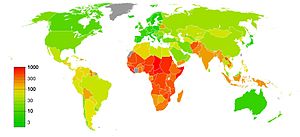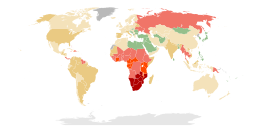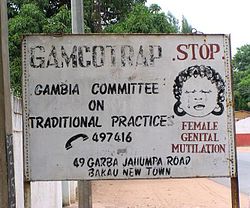Comprehensive sex education (CSE) is a sex education
instruction method based on-curriculum that aims to give students the
knowledge, attitudes, skills and values to make appropriate and healthy
choices in their sexual lives. The intention is that this understanding will prevent students from contracting sexually transmitted infections in the future, including HIV and HPV.
CSE is also designed with the intention of reducing unplanned and
unwanted pregnancies, as well as lowering rates of domestic and sexual violence, thus contributing to a healthier society, both physically and mentally.
Comprehensive sex education ultimately promotes sexual abstinence as the safest sexual choice for young people. However, CSE curriculums and teachers are still committed to teaching students about topics connected to future sexual activity, such as age of consent, safe sex, contraception such as: birth control, abortion, and use of condoms. This also includes discussions which promote safe behaviors, such as communicating with partners and seeking testing for sexually transmitted infections. Additionally, comprehensive sex education curricula may include discussions surrounding pregnancy outcomes such as parenting, adoption, and abortion. The most widely agreed benefit of using comprehensive sex education over abstinence-only sex education is that CSE acknowledges the student population will be sexually active in their future. By acknowledging this, CSE can encourage students to plan ahead to make the healthiest possible sexual decisions. This ideology of arming students to most successfully survive their future sexual experiences underlies the majority of topics within CSE, including condoms, contraception, and refusal skills.
Comprehensive sex education ultimately promotes sexual abstinence as the safest sexual choice for young people. However, CSE curriculums and teachers are still committed to teaching students about topics connected to future sexual activity, such as age of consent, safe sex, contraception such as: birth control, abortion, and use of condoms. This also includes discussions which promote safe behaviors, such as communicating with partners and seeking testing for sexually transmitted infections. Additionally, comprehensive sex education curricula may include discussions surrounding pregnancy outcomes such as parenting, adoption, and abortion. The most widely agreed benefit of using comprehensive sex education over abstinence-only sex education is that CSE acknowledges the student population will be sexually active in their future. By acknowledging this, CSE can encourage students to plan ahead to make the healthiest possible sexual decisions. This ideology of arming students to most successfully survive their future sexual experiences underlies the majority of topics within CSE, including condoms, contraception, and refusal skills.
History
As
of the year 2019, sex education in the United States is mandated on a
state level. It is up to the different states, districts, and school
boards to determine the implementation of federal policy and funds for
sex education. 24 out of the 50 U.S. states and the District of Columbia mandate sex education and 34 states mandate HIV education. Where sex education is mandated, there is no federal policy requiring the instruction of comprehensive sex education.
In prior years under the Bush administration, there was strong
support in congress by conservative republicans for the sanction of
abstinence-only-until-marriage sex education.
Under President Obama's administration, abstinence-only-until-marriage
sex education was opposed and suggested to be eliminated. Now under President Trump's administration, federal agenda has reverted back to supporting an abstinence approach.
The Centers for Disease Control and Prevention’s 2014 School Health
Policies and Practices Study found that on average high school courses
require 6.2 hours of taught class time on human sexuality, but only 4
hours or less on HIV, other sexually transmitted infections and
pregnancy prevention.
Benefits
Studies
have found that comprehensive sex education is more effective than
receiving no instruction and/or those who receive abstinence-only
instruction.
Acknowledging that people may engage in premarital sex rather than
ignoring it (which abstinence-only is often criticized for) allows
educators to give the students the necessary information to safely
navigate their future sexual lives.
CSE advocates argue that promoting abstinence without accompanied
information regarding safe sex practices is a disregard of reality, and
is ultimately putting the student at risk.
For example, programs funded under AEGP are reviewed for compliance
with the 8 standards (listed below in "Abstinence Education Grant
Program (AGEP) Requirements), but are not screened for medical accuracy.
Therefore, critics believe that students under these educational
programs are put at a disadvantage because it prevents them from making
informed choices about their sexual health. Additionally, under these
AEGP programs, health educators have referred to those that engage in
sex, especially females, as "dirty" and "used." They have also used
phrases such as "stay like a new toothbrush, wrapped up and unused" and
"chewed-up gum" to teach abstinence. Under a CSE model, language would
be more sensitive.
There is clear evidence that CSE has a positive impact on sexual
and reproductive health (SRH), notably in contributing to reducing STIs, HIV and unintended pregnancy.
Sexuality education does not hasten sexual activity but has a positive
impact on safer sexual behaviours and can delay sexual debut.
A 2014 review of school-based sexuality education programmes has
demonstrated increased HIV knowledge, increased self-efficacy related to
condom use and refusing sex, increased contraception and condom use, a
reduced number of sexual partners and later initiation of first sexual
intercourse.
A Cochrane review of 41 randomized controlled trials in Europe, the
United States, Nigeria and Mexico also confirmed that CSE prevents
unintended adolescent pregnancies.
CSE is very beneficial in regards to teen pregnancy because studies
show that, teen pregnancy and childbearing have a significant negative
impact on high school success and completion, as well as future job
prospects.
A study in Kenya, involving more than 6,000 students who had received
sexuality education led to delayed sexual initiation, and increased
condom use among those who were sexually active once these students
reached secondary school compared to more than 6,000 students who did
not receive sexuality education.
CSE also reduces the frequency of sex and the number of partners which
in turn also reduces the rates of sexually transmitted infections.
UNAIDS and the African Union
have recognized CSE’s impact on increasing condom use, voluntary HIV
testing and reducing pregnancy among adolescent girls and have included
comprehensive, age-appropriate sexuality education as one of the key
recommendations to fast track the HIV response and end the AIDS epidemic
among young women and girls in Africa.
As the field of sexuality education develops, there is increasing
focus on addressing gender, power relations and human rights in order
to improve the impact on SRH outcomes. Integrating content on gender and
rights makes sexuality education even more effective.
A review of 22 curriculum- based sexuality education programmes found
that 80 per cent of programmes that addressed gender or power relations
were associated with a significant decrease in pregnancy, childbearing
or STIs. These programmes were five times as effective as those
programmes that did not address gender or power.
CSE empowers young people to reflect critically on their environment
and behaviours, and promotes gender equality and equitable social norms,
which are important contributing factors for improving health outcomes,
including HIV infection rates. The impact of CSE also increases when
delivered together with efforts to expand access to a full range of
high- quality, youth-friendly services and commodities, particularly in
relation to contraceptive choice.
A global review of evidence in the education sector also found that teaching sexuality education builds confidence,
a necessary skill for delaying the age that young people first engage
in sexual intercourse, and for using contraception, including condoms.
CSE has a demonstrated impact on improving knowledge, self-esteem,
changing attitudes, gender and social norms, and building self-efficacy.
Criticism
Comprehensiveness
While
CSE implementation is on the rise in the United States, it remains
difficult for state officials to regulate what is and is not taught in
the classroom. This is due in large part to the undefinability of CSE;
CSE has the potential to comprise such a wide range of sexual
information, and over-all focus varies widely between curriculums.
Educators have also accused CSE as fundamentally operating as a form of
"abstinence-plus," due to the reality that CSE often involves minimal
body related information and excessive promotions of abstinence.
"So-called Comprehensive Sex Ed" says Sharon Lamb, a professor at the
University of Massachusetts Boston, "has been made less comprehensive as
curricula are revised to meet current federal, state, and local
requirements."
Inclusion of LGBT community
The
LGBT population experiences health disparities associated with stigma,
discrimination, negative connotations as well as stereotypes.
This population is subject to systemic barriers to adequate healthcare
services ultimately impacting their wellbeing and welfare negatively.
The care that they are provided with often is from clinicians who are
not trained well in addressing the concerns of this population.
This lack of training from the provider hinders the experience and
ultimately influences the quality of care and adequate delivery of
healthcare.
Due to discrimination and lack of cultural sensitivity that perpetuate
prejudice, this population experiences limited health-seeking behaviors.
Thus, making preventative services unattainable, furthermore,
increasing and prolonging illnesses and ailments. Research shows higher
risk of contracting HIV and other STDs; the number is increased when
assessing the intersecting population of gay men of color. Lesbian and bisexual females are less likely to obtain routine care like: breast and cervical cancer screenings.
Gay men are at an increased risk of prostate, testicular, anal, and
colon cancers, while lesbian and bisexual women have an increased risk
of ovarian, breast, and endometrial cancers.
As a result stigma, discrimination, victimization, and sexual abuse
LGBT youth is more likely to be involved in high-risk sexual behaviors
at an earlier age.
While comprehensive sex education exists in schooling, many
programs do not address the needs of the LGBT community. This population
faces different health disparities ultimately driven by discrimination,
shortfalls of peers, the lack of parental support, community services,
and school based sex education.
The implementation of LGBT comprehensive sex education utilized as an
intervention seeks to combat these health disparities, by informing the
population of the importance of developing sexual health.
Sexual health involves not only preventing disease, but also a
respectful approach to sexual relationships, sexuality, and accepting an
individual's gender iedntity and sexual orientation.
The term "comprehensive" is also often misleading because some
comprehensive programs do not show the holistic picture of human
sexuality. LGBT
advocates have long been critical of the ways in which comprehensive
sex education generally promotes marriage as the end goal for students.
LGBT advocates want to express other forms of relationships other than
marriage. Students should have sex education that encompasses the
different forms and should be allowed to exercise those forms in which
they are most comfortable with. Even when curriculums claim to be
inclusive of LGBT experiences, they often promote heteronormative
lifestyles as "normal." Inclusion of LGBT identities and health topics is necessary for LGBT students to feel safe and seen in their sex ed classrooms.
When sex education fails to include LGBT identities and experiences,
LGBT youth can be vulnerable to risky sexual behaviors and encourage
negative sexual health outcomes. Due to the lack of LGBT sex education
provided in schools, LGBT youth will look to peers and the internet
which can lead to misinformation. When these students do not have access to or an interest in marriage they are practically erased from the CSE narrative.
In a Canada, a federal report showed that LGBT community has less
access to health services and faces more comprehensive health
challenges compared to the general population. As a result of lack of
support for the LGBT population, the Comprehensive Health Education
Workers (CHEW) Project emerged in October 2014. Their goal is to educate
the LGBT community about topics such sexual and gender identity,
sexually transmitted infections (STIs), healthy social relationships,
and depression. They do this though workshops, arts‐based projects, and
one‐on‐one meetings. The CHEW project is set exclusively to the LGBT
community in order to establish a safe environment in which LGBT youth
can gain resources for sex education.
A cross sectional study done in New York City analyzed the sexual
behaviors of high school girls. Studies found that, "high school girls
who identified as LGBT were more likely to report substance use such as:
alcohol, marijuana, cocaine, heroin, meth, ecstasy and prescription
drugs. They also had higher rates of contemplating and/or attempting
suicide." Another study found that "the LGBT youth accesses health information online five times more than the heterosexual
population, and these rates are even higher for LGBT youth that
identify as a person of color which stems from the fact that they lack
health resources.
Rights, Respect, Responsibility includes an inclusive LGBT curriculum
for grades K-12. By having a curriculum, such as the Right, Respect,
Responsibility suggests, students will be have accurate information to
all identities as well as establish a safe classroom for LGBT students.
As of May 2018, only 12 states require discussion of sexual
orientation and of these, only 9 states require that discussion of
sexual orientation be inclusive (California, Colorado, Delaware, Iowa,
New Jersey, New Mexico, Oregon, Rhode Island, and Washington).
Additionally, several states have passed legislation that bans teachers
from discussing gay and transgender issues, such as sexual health and
HIV/AIDS awareness, in a positive light.
Furthermore, three states require that teachers only portray LGBT
people in a negative light (Alabama, South Carolina, and Texas).
School context
"Before
the late 1800s, delivering sex education in the United States and
Canada was primarily seen as a parent’s responsibility.
Today, programs under the Sexuality Information and Education Council
of the United States (SIECUS) begin comprehensive sex education in
pre-kindergarten, drawing criticism related to the age at which it is
appropriate to address sexual matters with children.
Federal funding for sexual education
Although
there is no federal mandate that requires states to teach sexual
education, there is federal funding available to assist with sexual
education programs.
Abstinence Education Grant Program (AGEP)
Historically,
funding for abstinence education has always been favored over CSE. In
1996, during Bill Clinton's presidency, legislation was passed to
promote abstinence in education programs. Under Title V Section 510 of
the Social Security Act, the Abstinence Education Grant Program (AGEP),
was passed. AEGP has always been renewed before its expiration date, and
each time funds gradually increase from fifty million dollars per year
to seventy-five and as high as $6.75 million per state grant in 2015.
The way the funds are disbursed are based on the proportion of
low-income children in each state. So far, thirty-six states have been
given AEGP funds.
Abstinence Education Grant Program (AGEP) Requirements
Part
of Section 510(b) of Title V of the Social Security Act, contains the
"A-H guidelines," which are the eight criteria that programs must abide
by order to be eligible to receive federal funding. They are as follows:
- A. Has as its exclusive purpose teaching the social, psychological, and health gains to be realized by abstaining from sexual activity;
- B. Teaches abstinence from sexual activity outside marriage as the expected standard for all school-age children;
- C. Teaches that abstinence from sexual activity is the only certain way to avoid out-of-wedlock pregnancy, sexually transmitted diseases, and other associated health problems;
- D. Teaches that a mutually faithful, monogamous relationship in the context of marriage is the expected standard of sexual activity;
- E. Teaches that sexual activity outside the context of marriage is likely to have harmful psychological and physical effects;
- F. Teaches that bearing children out of wedlock is likely to have harmful consequences for the child, the child's parents, and society;
- G. Teaches young people how to reject sexual advances and how alcohol and drug use increase vulnerability to sexual advances; and
- H. Teaches the importance of attaining self-sufficiency before engaging in sexual activity;
In addition to abiding by these 8 conditions, AGEP compliant programs
cannot discuss contraception, STIs, or methods for protecting against
STIs, except when describing failure rates.
Teen Pregnancy Prevention Program (TPP)
More recently legislation has pushed for funding that goes beyond abstinence only education.
In 2010, President Obama introduced the Teen Pregnancy Prevention
Program (TPP), which provides a total of $114.5 million annually to sex
education programs that are "medically accurate and age-appropriate."
TPP falls under a subsection of United States Department of Health and
Human Services ("HHS") which is overseen by the Office of Adolescent
Health. Funding for TPP is dispersed if "they emulate specific
evidence-based programs promulgated under TPP."
California Comprehensive Sexual Health and HIV/AIDS Prevention Education Act
In
January 2016, the California Healthy Youth Act, amended the California
Comprehensive Sexual Health and HIV/AIDS Prevention Education Act to
include minority groups and expand health education. Before it
authorized schools to provide comprehensive sex education and required
that all materials are made accessible to students with a variety of
needs. It also focused solely on marital relationships. It now mandates
that schools provide comprehensive sex education and states that
"materials cannot be biased and must be appropriate for students of all
races, genders, sexual orientations, and ethnic and cultural
backgrounds, as well as those with disabilities and English language
learners." Additionally, education must now include "instruction about
forming healthy and respectful committed relationships," regardless if
marital status. Furthermore, it is now required to have discussions
about all FDA-approved contraceptive methods in preventing pregnancy,
including the morning after pill.
In conclusion now requires that all sex education programs promulgated in the state should
- normalize sexuality as part of human development;
- ensure people receive integrated, comprehensive, accurate, and unbiased sexual health and HIV prevention and instruction; and
- provide pupils with the knowledge and skills to have healthy, positive, and safe relationships.
As a human right
Some critics state that young people’s access to CSE is grounded in internationally recognized human rights, which require governments to guarantee the overall protection of health, well-being and dignity, as per the Universal Declaration on Human Rights, and specifically to guarantee the provision of unbiased, scientifically accurate sexuality education.
These rights are protected by internationally ratified treaties,
and lack of access to sexual and reproductive health (SRH) education
remains a barrier to complying with the obligations to ensure the rights
to life, health, non-discrimination and information, a view that has
been supported by the Statements of the Committee on the Rights of the Child, the Convention on the Elimination of all Forms of Discrimination Against Women (CEDAW) Committee, and the Committee on Economic, Social and Cultural Rights.
The commitment of individual states to realizing these rights has
been reaffirmed by the international community, in particular the Commission on Population and Development
(CPD), which – in its resolutions 2009/12 and 2012/13 – called on
governments to provide young people with comprehensive education on
human sexuality, SRH and gender equality.
Other analysis show that comprehensive sex education is not an
international right nor a human right because it not clearly stated in
either a treaty nor custom. By international law, states are required to
provide access to information and education about reproductive health,
but this does not require a sex education curriculum. It may take
different forms such as mandating that local school districts create a
system for providing information to students, or mandating that health
clinics and practitioners dispense information to patients.
In curricula
Teaching methods
As
CSE gains momentum and interest at international, regional and national
levels, governments are increasingly putting in place measures to
scale-up their delivery of some form of life skills-based sexuality
education, as well as seeking guidance on best practice, particularly
regarding placement within the school curriculum.
Sexuality education may be delivered as a stand-alone subject or
integrated across relevant subjects within the school curricula. These
options have direct implications for implementation, including teacher
training, the ease of evaluating and revising curricula, the likelihood
of curricula being delivered, and the methods through which it is
delivered.
Within countries, choices about implementing integrated or
stand-alone sexuality education are typically linked to national
policies and overall organization of the curricula. The evidence base on
the effectiveness of stand-alone vs. integrated sexuality education
programming is still limited. However, there are discernible differences
for policy-makers to consider when deciding the position of CSE within
the curriculum.
As a stand-alone subject, sexuality education is set apart from
the rest of the curriculum, whether on its own or within a broader
stand-alone health and life skills curriculum. This makes it more
vulnerable to potentially being sacrificed due to time and budget
constraints, since school curricula are typically overcrowded.
However, a stand-alone curriculum also presents opportunities for
specialized teacher training pathways, and the use of non-formal
teaching methodologies that aim to build learners’ critical thinking
skills. The pedagogical approaches promoted through sexuality education –
such as learner-centred methodologies, development of skills and
values, group learning and peer engagement – are increasingly being
recognized as transformative approaches that impact on learning and
education more widely. As a standalone subject, it is also significantly
easier to monitor, which is crucial in terms of evaluating the
effectiveness of programming, and revising curricula where it is not
delivering the desired learning outcomes.
When sexuality education is integrated or infused, it is
mainstreamed across a number of subject areas, such as biology, social
studies, home economics or religious studies. While this model may
reduce pressure on an overcrowded curriculum, it is difficult to monitor
or evaluate, and may limit teaching methodologies to traditional
approaches.
Terminology
Apart
from the different teaching methods, termiology also differs. Abortion,
homosexuality, abstinence have connotations and definitions that vary
state. For example, the word "abstinence" may refer to disengaging from
all forms of sexual activities until marriage or may refer to only
disengaging from sexual intercourse. Furthermore, the degree of sexual
activity that "abstinence" connotates is often unclear, because sexual
behavior that is not sexual intercourse may or may not be included in
its definition. As a result, students are left confused about what
activities are risky and teachers do not know what they can and cannot
teach.
The term "comprehensive," is also falls on spectrum, therefore
can be considered an umbrella term. CSE means something radical for some
institutions while it can mean something moderate and even conservative
for others.
According to the Sexuality Information and Education Council of
the United States (SIECUS), the guidelines for comprehensive sexuality
education are as follows:
- appropriate to the age, developmental level, and cultural background of students;
- respects the diversity of values and beliefs represented in the community;
- complements and augments the sexuality education children receive from their families, religious and community groups, and healthcare professionals;
- teaches not only about abstinence, but also contraception, including emergency contraception and reproductive choice;
- teaches about lesbian, gay, bisexual, transgender (LGBT) issues and questions issues;
- teaches anatomy, development, puberty, and relationships;
- teaches all of the other issues one would expect to be covered in a traditional sexuality education class; and
- should be science-based and medically accurate
Sexual education exemption
Just
as teaching methods and curricula vary by state, excusal from sex
education also varies by state. States may have with an opt out or opt
in produce. In some states, students can opt out of receiving sexual
education without specifying a particular reason. In other states,
students can only opt out for religious or moral reasons. In an opt-in
provision, parents must actively agree to allow their children to
receive sex education prior to the start of the sexual education.
Sexual content in the media
Since 1997, the amount of sexual content on TV has nearly doubled in the United States.
Additionally, a study done in 2008 showed that nearly 40% of popular
music lyrics contained sexual references which were often sexually
degrading. These lyrics were also often accompanied with mentions of
other risk behaviors, such as substance use and violence.
Teens (ages 13–15) in the United States, use entertainment media
as their top source for education in regards to sexuality and sexual
health. Additionally, a study found that 15-19 year olds in the U.S use
media far more than parents or schools to obtain information about birth
control.
Some studies have found that, "very few teen television shows mention
any of the responsibilities or risks (e.g., using contraception,
pregnancy, STIs) associated with sex and almost none of the shows with
sexual content include precaution, prevention, or negative outcomes as
the primary theme."
Television shows 16 and Pregnant and its spin-off, Teen Mom, which
first aired on MTV in 2009 received major disapproval from some parents
as they thought the shows glamorized teen pregnancy and motherhood.
However, 16 and Pregnant actually led to a 4.3 percent reduction in teen
pregnancy, mostly as a result of increased contraceptive use.
In contrast, other data shows that exposure to high levels of sexual
content on the television causes adolescents to have twice the risk of
becoming pregnant in the following 3 years, compared to those who were
exposed to low levels.
The film Mean Girls, directed by Mark Waters shed light on the
state sex education in some parts of the United States. In the film the
health instructor states, "At your age, you're going to have a lot of
urges. You're going to want to take off your clothes and touch each
other. But if you do touch each other, you will get chlamydia and die."
This line is meant to be satirical, but it illustrates common flaws
within sex education in the U.S. It depicts simplistic descriptions of
sexual activity and implementation of fear without any legitimate basis.
Comprehensive sex education is the main topic in the documentary The Education of Shelby Knox released in 2005 about Lubbock, Texas, which has one of the highest teen pregnancy and STD rates in the nation. The "solution" to which is a strict abstinence-only sex education curriculum in the public schools and a conservative preacher who urges kids to pledge abstinence until marriage.
In 2013, How to Lose Your Virginity was released, a documentary that questioned the effectiveness of the abstinence-only sex education movement and observed how sexuality continues to define a young woman's morality and self-worth. The meaning and necessity of virginity as a social construct is also examined through narration and interviews with notable sexuality experts, such as former Surgeon General Dr. Joycelyn Elders, "Scarleteen" creator and editor Heather Corinna, historian Hanne Blank, author Jessica Valenti, and comprehensive sex education advocate Shelby Knox.
Not only have films portrayed sex education, but so has social media. Platforms such as YouTube, Facebook, Vine, and others are used as a tool to uplift the narratives of marginalized communities such as persons of color and LGBT persons in hopes to "strengthen sexual health equity for all."
As a result of the mass amount of sex content in media, media
literacy education (MLE) has emerged. It was created to address the
influence of unhealthy media messages on risky health decisions, such as
intention to use substances, body image issues, and eating disorders.
A study analyzed the effectiveness of a teacher-led MLE program, called
Media Aware Sexual Health (MASH), which provides students with accurate
health information and teaches them how to apply that information to
critical analysis of media messages. This comprehensive sex education
resulted in increased intentions to talk to a parent, partner and
medical professional prior to sexual activity, and intentions for condom
use.
Due to knowledge gaps in most sex education curricula for teens, free online resources like Sex, Etc., Scarleteen.com, and teensource.org have been created to promote comprehensive, inclusive, and shame-free sex education for teenagers.
















